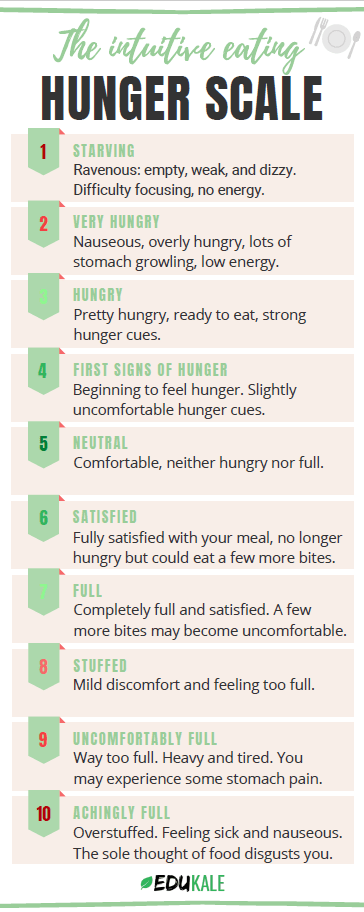This post contains affiliate links from which I may receive a small commission, at no extra cost to you. In no way does this affect my opinion or the information I provide on the product. Please read my disclaimer for more info.
Do you find it hard to know when to eat and when to stop eating? Do you wish you could stop eating to the point of feeling overly full and sick?
Are you interested in practicing mindful eating and intuitive eating but don’t know where to start?
Then the intuitive eating hunger scale is the tool you need! It will help you reconnect with your hunger and fullness cues and help you eat more intuitively.

What is the intuitive eating hunger scale?
The intuitive eating hunger scale [1] is a tool that can be used to help you identify your level of hunger or fullness. It helps you be more in tune with your body’s signals and enables you to self-regulate.
The scale goes from 1 to 10, 1 being ravenous, 10 being achingly full, and 5 being a neutral middle ground.
How to use the hunger and fullness scale.
- Before eating, take some time to focus your attention on your stomach.
Can you feel some signs of hunger? Where would you position yourself on the scale?
Ideally, you should start thinking about cooking/getting ready to eat at a 4 so that you can eat before reaching a 1 or 2. If you eat an amount of food that’s suitable for your needs, you should start to reach level 4 around 3-5 hours after a full meal.
- During your meal, take the time to pause after every few bites to reassess your position on the hunger scale. Make sure to eat slowly, to take the time to chew, and to put your fork down as often as you can, which are some of the steps of mindful eating. Look out for the signs that you’re starting to get comfortably full.
- You should be finishing up your meal around a 6 or a 7, even if your plate isn’t completely empty. It’s fine to save that food for later or to throw it out if you really don’t want it. The more you get used to listening to your hunger cues, the easier it’ll be to serve yourself the correct portion size from the start. Except during the occasional Christmas dinner, you should really try to stop eating before reaching a 9 or 10.

How to eat intuitively with the hunger scale.
Now that you know what the intuitive eating hunger scale is and how to use it, here’s how you can implement it easily.
To start with, try it out for only one meal so you can focus on it properly without feeling overwhelmed. Maybe choose a weekend meal where you have no imposed meal times.
Wait until you are around a 4 to start preparing your meal. Try to start eating between a 4 and a 3.
Create a healthy, balanced plate that you enjoy, but don’t begin with your favorite food ever that causes you to overeat. Start eating slowly, without any distractions.
A few bites in, try to assess whether your position on the scale is starting to change or not. When you’ve finished half of your plate, take a break. Put your silverware down and push your plate to the side.
Close your eyes and focus on your stomach. Where are you on the scale now? If you’re at a 4 or 5, keep going. If you’re at a 6 or 7 and feel fully satisfied, stop and save the food for later.
Around 20 minutes after your meal, you can check in with yourself again. Are you feeling more full than you were? Do you wish you would’ve stopped eating sooner? Or maybe later? Keep this in mind for your next meal.
You can write all of this process down if you feel like it: it should be easier to track your progress this way.
Remember that this is going to be difficult at first and is going to require some energy, but the more you practice it, the more automatic it will become.
What happens when I’m at the extremes?
As much as possible, it’s important to start eating before reaching a 1 and to stop eating before reaching a 10. But no one is perfect and this will probably happen to you at some point— so here’s how to cope.
If you are at a 2 or 1 and still haven’t eaten:
If you get to this point, you are going to be ravenous and have the desire to eat anything and everything in front of you. I suggest eating a small amount of food (some fruit, some raw veggies, some nuts…) to get a bit higher on the scale.
After a few minutes, you’ll feel more at ease to make healthy and conscious food decisions. This is a lot harder to do when you are starving!

If you stop eating at 9 or 10:
If you get to this point, you are going to start feeling uncomfortably stuffed and might even feel sick. This often happens when you are a restaurant, at an all-you-can-eat buffet, or during a holiday dinner.
The first thing you need to do is to tell yourself that it is okay. You are not disgusting because you overate. One meal isn’t going to ruin all of your healthy and conscious eating efforts.
If you feel food guilt afterward, check out this article to help you get rid of it.
After the meal, all there is to do is wait it out. The discomfort won’t last that long. Try to be extra in tune with your hunger cues for the following meal.
You’ll likely be less hungry or wish to eat later than usual and that is totally fine. Honor your body’s signals. The wrong thing to do here would be to starve yourself for “punishment”.
Do I have to use the scale all the time?
It’s a good idea to use the hunger scale often so that checking in with your hunger cues becomes second nature. However, there will be instances when it won’t be possible.
Say you aren’t very hungry at lunchtime but have a long meeting coming along and won’t be able to eat until a few hours later. The smart move would be to eat a small meal now, for practical reasons, even if the physical cues aren’t there.
I also remember pushing myself to eat before dance recitals, even if I wasn’t hungry, just so I would have enough energy! It’s up to you to be the judge of these situations and to decide when to honor your practical hunger.

The intuitive eating hunger scale in conclusion.
The intuitive eating hunger scale is a great tool to help you identify your hunger levels and help you be more in tune with your physical cues. The scale goes from 1 to 10, 1 being ravenous and 10 being achingly full.
You should assess your position on this scale before, during, and after meals. Try to start eating at a 3 or 4 and stop eating at a 6 or 7. At first, you might find this annoying and difficult, but it will quickly become automatic!
-Lucie


